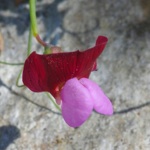Lathyrus clymenum
Crimson pea Λάθυρος

Fabaceae - pea family Dicot.
Lathyrus clymenum
Crimson pea Λάθυρος

Fabaceae - pea family Dicot.
Lathyrus clymenum has attractive crimson and pink flowers, narrow grass-like leaves, winged stems and twirling branched tendrils.
There is archaeological evidence from the Minoan city of Akrotiti, that L. clymenum was cultivated on Santorini 3,500 years ago. The plants are still grown on the island and the yellow peas used to make the famous Fava Santorinis, a product which has been recognised as a Protected Designation of Origin product. L. clymenum grows wild on Skopelos, one could peculate that it was introduced by the Minoans.



lathyrus from Greek name lathyros (λάθυρος) for the plant
Clmenum from latin clymenus = scorpion’s tail


Lathyrism
“men and women who ate peas continuously became impotent upon the legs”
Hippocrates
Lathyrism is a condition which can cause paralysis of the legs, resulting from ingestion of raw peas from the genus Lathyrus. The seeds contain a substance, which can damage the nerves; it affects both man and domestic animals. Not everyone is susceptible and it is necessary for the diet to contains a significant portion of these pulses eaten over several months. The lathyrus pea, L. sativa, is the main cause but also L. cicera, L. clymenum & L. setifolia.
Described by Hippocrates, lathyrism was first recognised by the ancient Greeks and has resulted in outbreaks of paralysis over the centuries in Europe and India. It is a disease associated with famine and last occurred in Greece during World War II, when 97 people were affected.1
These peas are tasty and highly nutritious; they can be eaten raw in small quantities and as the toxin is destroyed by heat, and in larger portions if soaked and well cooked.
1.Barrow et. al. Lathyrism: a Review. The Quarterly Review of Biology. 1974.